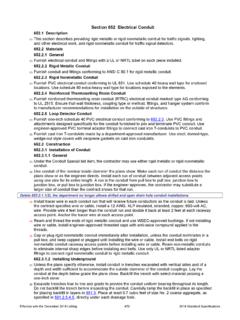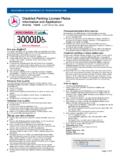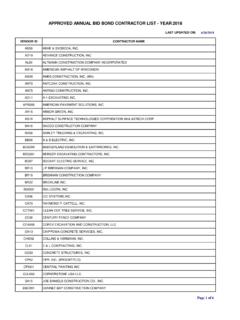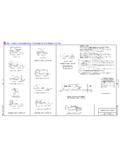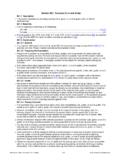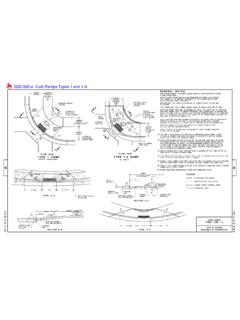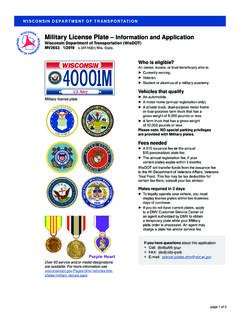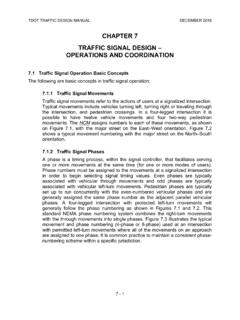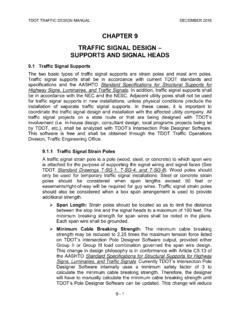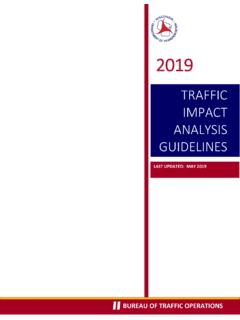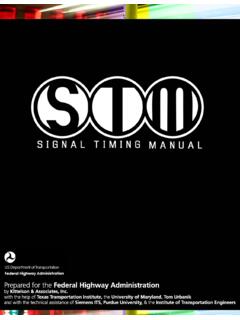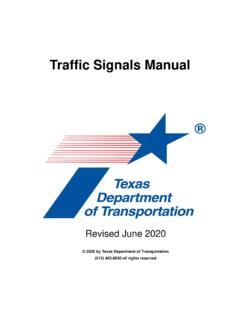Transcription of acilities Development ManualF Wisconsin Department of ...
1 Page 1 Facilities Development Manual Wisconsin Department of Transportation Chapter 11 design Section 26 Roundabouts FDM 11-26-1 General June 24, 2016 General This section and its sub-sections are comprised of roundabout design and operations guidelines developed through research and experience.
2 Much of the prescribed guidance has been proven through application, evaluation and refinement - a truly continuous improvement process. The Department has updated previous versions of this guide to account for changes in national roundabout guidelines made possible through research, namely NCHRP 572 - Roundabouts in the United States, 2006 and NCHRP 672, Roundabouts: An Informational Guide, Second Edition. The NCHRP guidelines and research are heavily relied upon in this chapter. Where appropriate and justified by local experience, exceptions for use by the Wisconsin Department of Transportation are noted. Where both references are cited but differences exist, the Facilities Development Manual guidance shall govern. The modern roundabout is a subset of many types of circular intersections.
3 The term modern roundabout and roundabout are used interchangeably throughout this document. The roundabout is a one-way circular intersection where circulating traffic is given priority over entering traffic and where entry speeds are low relative to older unconventional circular intersections. The term modern roundabout is used in the United States to differentiate roundabouts from the older and often large diameter nonconforming traffic circles, rotaries or very small traffic calming circles used on residential streets. traffic circles fell out of favor in this country by the mid 1950 s because they encountered safety and operational problems as traffic volumes increased beyond their operational thresholds. However, substantial progress has been achieved in the subsequent design of circular intersections, and the modern roundabout should not be confused with the traffic circles of the past.
4 Roundabouts may be considered for a wide range of intersection types including but not limited to freeway interchange ramp terminals, state route intersections, and state route/local route intersections. Roundabouts generally process high volume left turns more efficiently than all-way stop control or traffic signals, and will process a wide range of side road volumes. Roundabouts can improve safety by reducing vehicle speeds and eliminating crossing conflicts that are present at conventional intersection. The required intersection sight distance is greatly reduced from what is required for a signalized intersection due to the reduced intersection speeds. The modern roundabout is defined by three basic principles: 1. Yield-at-Entry - Vehicles approaching the roundabout must wait for a gap in the circulating flow, or yield, before entering the circle.
5 2. Deflection - traffic entering the roundabout is directed or channeled to the right with a curved entry path into the circulating roadway. 3. Geometric Curvature - The radius of the circular road and the angles of entry are designed to slow the speed of vehicles. The following is a list of locations where a roundabout may be feasible: 1. Intersections with a high-crash rate or a higher severity of crashes 2. High-speed rural intersections 3. Freeway ramp terminals 4. Transitions in functional class or desired speed change (including rural to urban transitions) 5. Existing intersections that are failing 6. Aesthetics is an objective 7. Intersections of dissimilar functional class (arterial-arterial, arterial-collector, arterial-local, collector-collector, collector-access) 8.
6 Four-leg intersections with entering volumes less than 5,000 vph or approximately 50,000 ADT 9. Three-leg intersections 10. Intersection of two signalized progressive corridors where turn proportions are heavy (random arrival is better than off-cycle arrival) 11. Closely spaced intersections where signal progression cannot be achieved 12. Locations where future access will be added to the intersection FDM 11-26 Roundabouts Page 2 13.
7 Replacement of all-way stops 14. Intersections near schools 15. Intersections where safety is a major concern FHWA and AASHTO have made intersection safety a high priority. The objective is to improve the safety and operation of intersections. When compared to signalized intersections, studies by the Insurance Institute for Highway Safety [1] show that roundabouts typically reduce overall delay and congestion, increase capacity, and improve safety. For example, right-angle collisions are a prominent cause of death at signalized intersections. Studies by the Insurance Institute for Highway Safety show that signalized intersections converted to roundabouts experienced on average: 75% fewer injury crashes, 90% fewer fatality crashes, and fewer crashes overall.
8 Wisconsin roundabout safety has been studied with encouraging results. In a study of roundabout collision history, prepared by the University of Wisconsin traffic Operations and Safety Laboratory [4], local researchers analyzed 24 roundabouts that were built in Wisconsin in 2007 or before. Three years of before and after crash data were gathered as well as geometric and volume data. An Empirical Bayes (E-B) analysis was used to examine the safety benefits for total crashes and injury crashes. A simple before-and-after crash analysis was also completed to analyze specific types of injury crashes for each roundabout . The E-B analysis was performed using Safety Performance Functions (SPFs) from both the Highway Safety Manual (HSM) and Wisconsin specific data.
9 The results from both values were very similar adding strength to the numbers. Using the HSM SPFs, researchers found mixed results for total crash frequency but a significant decrease in crash severity. Nationally, a 35% reduction was observed for all crashes as noted in NCHRP Report 572 while Wisconsin roundabouts showed a 9% decrease across the 24 roundabouts. Wisconsin roundabouts had a decrease of 52% for fatal and injury crashes. Roundabouts nationwide are also experiencing a significant decrease in severe crashes. When looking at predictor variables, the speed limit of the approaches did not show a significant impact on the safety of the roundabout . While multilane roundabouts seem to be safer than single lane roundabouts when looking at fatal and injury crashes, single lane roundabouts saw a larger decrease in total crashes.
10 Two-way stop controlled conversions had the highest safety benefit as compared to All-way stop controlled and signalized. According to FHWA, some or all of the following safety benefits can be realized with proper roundabout design and implementation: - Provide more time for entering drivers to judge, adjust speed for, and enter a gap in circulating traffic , allowing for safer merges - Reduce the size of sight triangles needed for users to see one another - Increase the likelihood of drivers yielding to pedestrians (compared to an uncontrolled crossing) - Provide more time for all users to detect and correct for their mistakes or mistakes of others - Make crashes less frequent and less severe, including crashes involving pedestrians and bicyclists - Make the intersection safer for novice users Critical to the acceptance of the roundabout intersection is overcoming the internal and external skepticism of its advantages and value compared to stop controlled or signalized intersections.
